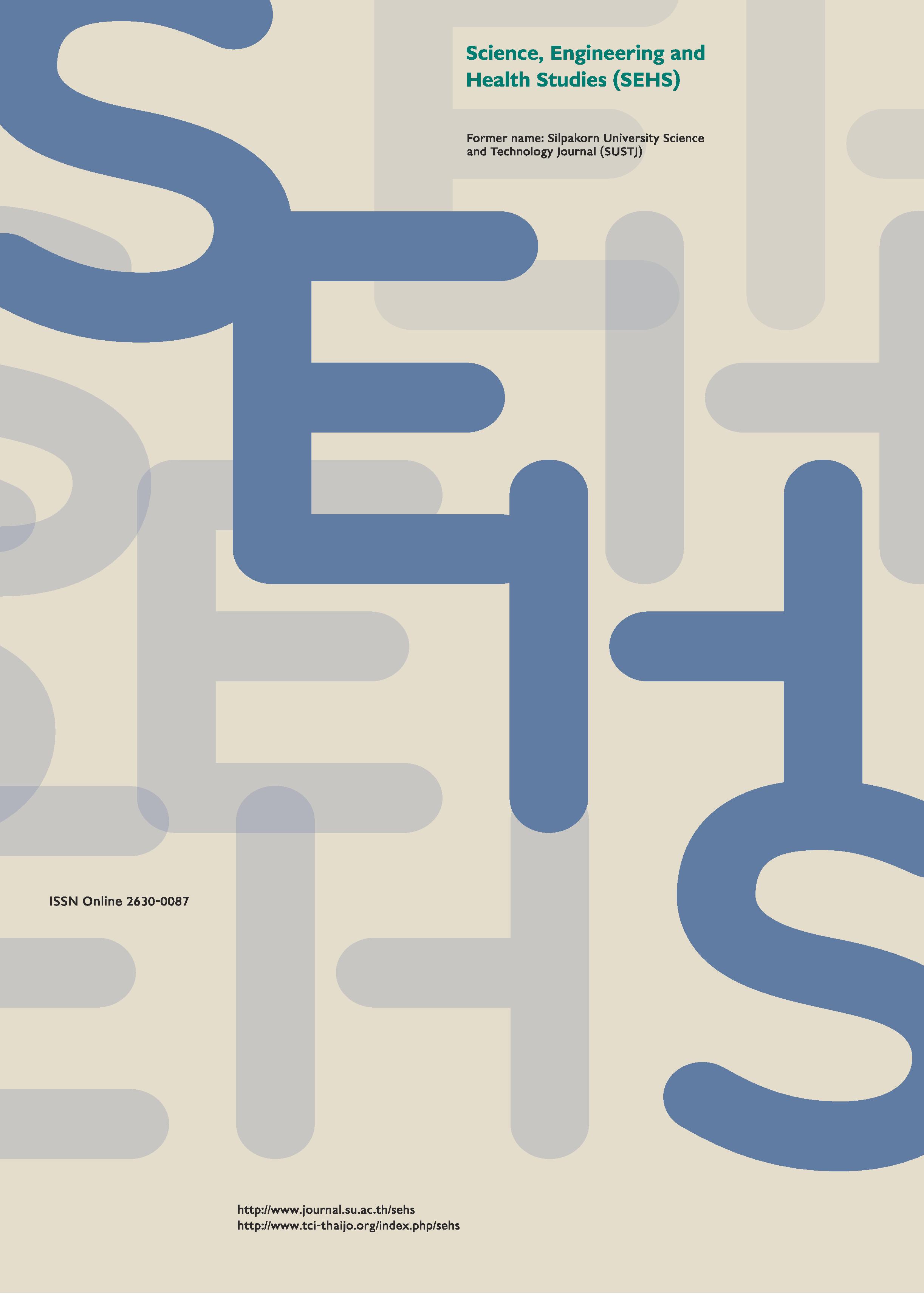Bacterial cellulose production and applications
Main Article Content
Abstract
Cellulose is a polysaccharide or a carbohydrate polymer which is found in many tropical plants. Cellulose is not only a main structural material of plants, but it is also able to be produced by bacteria. Bacterial cellulose is a biomaterial which is produced from bacteria with high purity (free of lignin and hemicellulose), high crystallinity, high tensile strength, high biocompatibility, and a high degree of polymerization and nanostructure. It is used in the medical, cosmetics, paper, food, and textile industries. In general, biosynthesis of bacterial cellulose requires a carbon source, such as a monosaccharide (glucose and fructose), a disaccharide (sucrose and maltose) or alcohol (ethanol, glycerol and mannitol), for the fermentation process to secrete an extracellular insoluble film. However, they are expensive and of low yield, which affect the cost of productivity. Attempts to find new carbon sources for bacterial cellulose production from alternative materials include effluent from food processing, liquor, molasses, juice, wheat straw and fruit pulp, etc. New carbon sources may lead to an increase in productivity and a reduction in economic cost. Moreover, using waste as a carbon source not only improves the yield of bacteria cellulose, but also reduces the environmental pollution associated with industrial waste disposal.
Downloads
Article Details
References
Bielecki, S., Krystynowicz, A., Turkiewicz, M., and Kalinowska, H. (2002). Bacterial cellulose. In Polysaccharides I: Polysaccharides from Prokaryotes (Vandamme, J., Baets, S.D., and Steinbüchel, A., eds.), pp. 37-90. Wiley-VCH Verlag, Weinheim.
Castro, C., Zuluaga, R., Alvarez, C., Putaux, J., Caro, G., Mondragon, I., and Ganan, P. (2011). Structural characterization of bacterial cellulose produced by Gluconacetobacter swingsii sp. from Colombian agroindustrial wastes. Carbohydrate Polymers, 84, 96-102.
Castro, C., Zuluaga, R., Alvarez, C., Putaux, J., Caro, G., Rojas, O., Mondragon, I., and Ganan, P. (2012). Bacterial cellulose produced by a new acid-resistant strain of Gluconacetobacter genus. Carbohydrate Polymers, 89, 1033-1037.
Cavka, A., Guo, X., Tang, S., Winestrand, S., Jonsson, L., and Hong, F. (2013). Production of bacterial cellulose and enzyme from waste fiber sludge. Biotechnology for Biofuels, 6(25), 1-10.
Chawla, P., Bajaj, I., Survase, S., and Rekha, S. (2009). Microbial cellulose: fermentative production and applications. Food Technology and Biotechnology, 47(2), 107-124.
Chen, L., Hong, F., Yang, X., and Han, S. (2013). Biotransformation of wheat straw to bacterial cellulose and its mechanism. Bioresource Technology, 135, 464-468.
Feng, X., Ullah, N., Wang, X., Sun, X., Li, C., Bai, Y., Chen, L., and Li, Z. (2015). Characterization of Bacterial Cellulose by Gluconacetobacter hansenii CGMCC 3917. Journal of Food Science, 8(10), 2217-2227.
Festucci-Buselli, R. A., Otoni, W. C. and Joshi, C. P. (2007). Structure, organization, and functions of cellulose synthase complexes in higher plants. Brazilian Journal of Plant Physiology, 19(1), 1-13.
Fu, L., Zhou, P., Zhang, S., and Yang, G. (2013). Evaluation of bacterial nanocellulose-based uniform wound dressing for large area skin transplantation. Materials Science and Engineering:C, 33(5), 2995-3000.
Gayathry, G., and Gopalaswamy, G. (2014). Production and characterization of microbial cellulosic fiber from Acetobacter xylium. Indian Journal of Fiber and Textile Research, 39, 93-96.
George, J., Ramana, K.V., Sabapathy, S. N., and Bawa, A. S. (2005). Physico-mechanical properties of chemically treated bacterial (Acetobacter xylinum) cellulose membrane. World Journal of Microbiology and Biotechnology, 21(8-9), 1323-1327.
Gomes, F., Silva, N., Trovatti, E., Serafim, L., Duarte, M., Silvestre, A., Neto, C., and Freire, C. (2013). Production of bacterial cellulose by Gluconacetobacter sacchari using dry olive mill residue. Biomass and Bioenergy, 55, 205-211.
Hong, F., Guo, X., Zhang, S., Han, S., Yang, G., and Jonsson, L. (2012). Bacterial cellulose production from cotton-based waste textiles: Enzymatic saccharification enhanced by ionic liquid pretreatment. Bioresource Technology, 104, 503-508.
Keshk, SMAS. (2014). Bacterial cellulose production and its industrial applications. Journal of Bioprocessing & Biotechniques, 4(2), 1-10.
Keshk, SMAS. (2014). Vitamin C enhances bacterial cellulose production in Gluconacetobacter xylinus. Carbohydrate Polymers, 99, 98-100.
Kongruang, S. (2008). Bacterial cellulose production by Acetobacter xylinum strains from agricultural waste products. Applied Biochemistry and Biotechnology, 148(1-3), 245-256.
Kumbhar, J. V, Rajwade, J. M, and Paknikar, K. M. (2015). Fruit peels support higher yield and superior quality bacterial cellulose production. Applied Microbiology and Biotechnology, 99(16), 6677-6691.
Lin, D., Lopez-Sanchez, P., Li, R., and Li, Z. (2014). Production of bacterial cellulose by Gluconacetobacter hansenii CGMCC 3917 using only waste beer yeast as nutrient source. Bioresource Technology, 151, 113-119.
Lin, S., Calvar, I., Catchmark, J., Liu, J, Demirci, A., and Cheng, K. (2013). Biosynthesis, production and applications of bacterial cellulose. Cellulose, 20, 2191-2219.
Moniri, M., Moghaddam, A. B., Azizi, S., Rahim, R. A., Ariff, A. B., Saad, W. Z., Navaderi, M., and Mohamad, R. (2017). Production and Status of Bacterial Cellulose in Biomedical. Engineering Nanomaterials (Basel), 7(9), 257. doi: [10.3390/ nano7090257]
Phruksaphithak, N., Kaewnun, C., and O-Thong, S. (2017). Production and properties of bacterial cellulose from oil palm shoot juices felled medium and coconut medium. Key Engineering Materials, 728, 271-276.
Shaha, N., Ul-Islam, M., Khattak, W., and Park, J. (2013). Overview of bacterial cellulose composites: a multipurpose advanced material. Carbohydrate Polymers, 98, 1585-1598.
Shi, Z., Zhang, Y., Phillips, G., and Yang, G. (2014). Utilization of bacterial cellulose in food. Food Hydrocolloids, 35, 539-545.
Tanskul, S., Amornthatree, K., and Jaturonlak, N. (2013). A new cellulose-producing bacterium, Rhodococcus sp. MI 2: Screening and optimization of culture conditions. Carbohydrate Polymers, 92, 421-428.
Ul-Islam, M., Khan, T., and Park, J. K. (2012). Nanoreinforced bacterial cellulose-montmorillonite composites for biomedical applications. Carbohydrate Polymers, 89, 1189-1197.
Wu, J., and Liu, R. (2012). Thin stillage supplementation greatly enhances bacterial cellulose production by Gluconacetobacter xylinus. Carbohydrate Polymers, 90, 116-121.
Yang, Y., Jia, J., Xing, J., Chen, J., and Lu, S. (2013). Isolation and characteristic analysis of novel high bacterial cellulose producing strain Gluconacetobacter intermedius CIs26 Carbohydrate Polymers, 92, 2012-2017.
Yoshinaga, F., Tonouchi, N., and Watanabe, K. (1997). Research progress in production of bacterial cellulose by aeration and agitation culture and its application as a new industrial material. Bioscience, Biotechnology, and Biochemistry, 61(2), 219-224.

